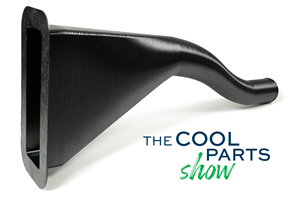LFAM Phase Two: How Companies Are Going Farther With Large-Part 3D Printing
The freedom to produce very large components more easily is an underappreciated AM advantage, but one that is now established. Recently posted articles show the way forward for large-format additive manufacturing (LFAM) in contract and in-house production, as well as in construction.
Share
Read Next
“Additive manufacturing” is a broad term: It describes a range of digital manufacturing processes and possibilities — but the path of adoption for any of them is broadly similar. Indeed, I see two major phases in the early course of adoption of any AM process or possibility. Phase 1: The AM option in question has to prove itself, demonstrating it can print the part and perform production. Once this is established or the largest doubts are answered, then comes Phase 2: The AM option is used and improved for use. It is streamlined, rethought and refined to address its barriers, uncertainties, inefficiencies and costs.
And perhaps the latest mode of AM to make the transition to Phase 2 is large-format additive manufacturing (LFAM). Cases of LFAM making that transition appear in various recent articles we have posted.
Greater freedom to manufacture large components and tools is an important advantage of additive, though underappreciated. I do not know why this freedom is not more routinely seen among additive’s strengths. It should be. AM is for assembly consolidation, geometric complexity, internal cooling, mass customization, metamaterials, speed to market, supply chain resiliency, sustainability, sustainment, toolingless production … and big parts. With additive, large-scale component fabrication is free of large forces, and this is (forgive the pun) huge. No more moving a massive mold or workpiece through the shop to get the job started. With 3D printing, begin the large part’s production without a large load.

Talking with the team at Additive Engineering Solutions. Seen here (L to R): Nick Luther, me, Austin Schmidt. More in our article about the company’s recent installation of a robot for LFAM.
That Phase 2 for LFAM has now begun was clear to me after paying a visit to Additive Engineering Solutions (AES). This company was founded to pursue the benefit of AM we are considering: making big components. And in now embracing robot 3D printing as a new, alternate way for the company to perform this work, co-founder Austin Schmidt described for me the departure from the company’s established work with large gantry machines and the mindset change the team must make as a result.
But wait: Mindset change? This very company, AES, only seven years ago was founded on a mindset change. Has it already become so set in its ways, so established in the still-new idea of 3D printing large parts, that it needs to step outside its habits and embrace change?
Apparently yes. AES has come to this point. This is what is happening for LFAM.
Three articles we have reported very recently all explore this theme of LFAM Phase 2. Three different stories describe companies taking established success with large-format digital manufacturing and stepping beyond it to succeed in a more scalable way. Contract manufacturer AES is learning the role and advantages of robot 3D printing alongside gantry 3D printing of polymer composite. Furniture maker Model No. shifted from engineering its own LFAM equipment to now producing on commercially available machines. And a newcomer to construction-related 3D printing, Alquist 3D, is furthering this newly established additive opportunity by considering alternate materials and an alternate business model compared to AM for construction so far.
The last of these articles possibly hints at the next phase to come. Training the providers of construction 3D printing in various geographic regions is part of how Alquist 3D is preparing for the technology’s advance. Because I am only now heralding LFAM Phase 2, I will not speculate on Phase 3. Except to say this much: The phase to follow will almost certainly involve organizational expansion — with many more people and companies involved in LFAM, all competing and collaborating with one another as they largely take for granted that 3D printing is simply the way large components get made.
Related Content
Aircraft Ducts 3D Printed in Composite Instead of Metal: The Cool Parts Show #68
Eaton’s new reinforced PEKK, tailored to aircraft applications, provides a cheaper and faster way to make ducts compared to formed aluminum.
Read MoreSustainable Furniture Company Model No. Maintains Product Focus with Switch from DIY to Industrial 3D Printers
The startup founded in 2018 has matured in its product offerings as well as its manufacturing equipment, moving from homegrown 3D printers to industrial large-format machines.
Read MoreRobot Vs. Gantry for Large-Format Additive Manufacturing (Includes Video)
Additive Engineering Solutions, specialist at 3D printing very large parts and tools on gantry machines, now also uses a robot for large-format AM. Here is how the robot compares.
Read More8 Cool Parts From Formnext 2023: The Cool Parts Show #65
New additive manufacturing technologies on display at Formnext were in many cases producing notable end-use components. Here are some of the coolest parts we found at this year’s show.
Read MoreRead Next
Robot Vs. Gantry for Large-Format Additive Manufacturing (Includes Video)
Additive Engineering Solutions, specialist at 3D printing very large parts and tools on gantry machines, now also uses a robot for large-format AM. Here is how the robot compares.
Read MoreAlquist 3D Looks Toward a Carbon-Sequestering Future with 3D Printed Infrastructure
The Colorado startup aims to reduce the carbon footprint of new buildings, homes and city infrastructure with robotic 3D printing and a specialized geopolymer material.
Read MoreSustainable Furniture Company Model No. Maintains Product Focus with Switch from DIY to Industrial 3D Printers
The startup founded in 2018 has matured in its product offerings as well as its manufacturing equipment, moving from homegrown 3D printers to industrial large-format machines.
Read More





















